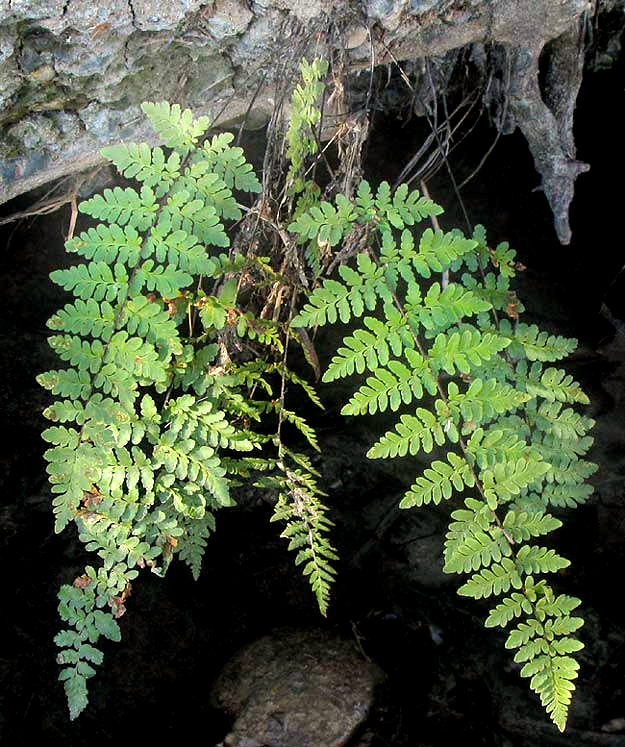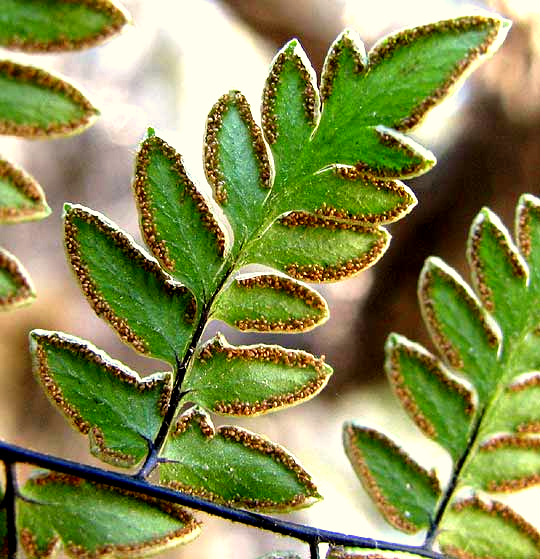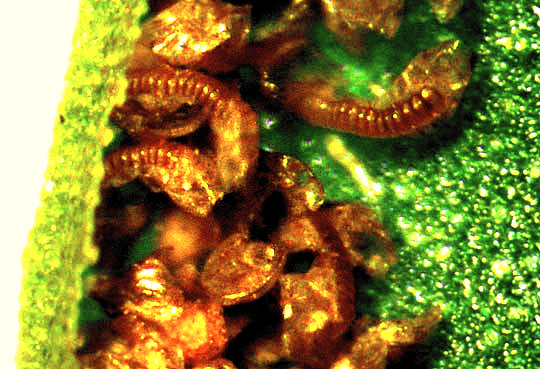Excerpts from Jim Conrad's
Naturalist Newsletter

from the January 27, 2013 Newsletter issued from the valley of the Dry Frio River in northern Uvalde County, southwestern Texas, on the southern border of the Edwards Plateau; elevation ~1750m (~5750 ft); N29.62°, W99.86°; USA
ALABAMA LIPFERN
Down behind the cabin where the little Dry Frio River runs beside a vertical limestone wall I've been putting off identifying a certain hand-sized, frilly little fern until it began producing spores. Lots of fern species are hand-sized and frilly looking, but normally they can be distinguished from one another by how they arrange their spore-producing parts. Above you can see some fronds growing from cracks in a limestone rock.
The field mark I've been waiting for is seen on a frond's underside below:

Instead of grouping its spore-producing sporangia into dots or lines scattered in distinctive patterns across the undersurface of the leaflets, or "pinnae," this fern's sporangia are ordered in continuous lines beneath the curled-under margins of its pinnae. Not many fern species do this, and when I saw it immediately I knew we had a member of that group of ferns known as lip ferns, the "lip" being the pinnae edges partially folding over the sporangia.
This lip fern keys out to the Alabama Lipfern, CHEILANTHES ALABAMENSIS*, a fairly common species within its unusual distribution area, which is mostly in regions of limestone outcrop in the southern Appalachians, Alabama and Tennessee and westward through Arkansas and Texas into northern Mexico's arid northern states.
You might notice that the pinnae margins on the fronds in the first picture are less scalloped than on those in the second picture. That's because fronds in the first picture were sterile, and pinnae margins on sterile fronds are slightly different -- more curvy -- from those on pinnae with spores tucked into their curved-under margins.
Having a dissecting scope handy I decided to look at this fern's sporangia, and saw what's shown below:

In that picture a curled-under pinna margin runs along the left side. To understand the items that look like segmented centipedes you must take into account how fern sporangia work.
Sporangia are tiny, baglike, more or less spherical affairs holding spores. Each sporangium of the Alabama Lipfern typically contains 32 spores; other species often have different spore numbers. To help the microscope spores disseminate into the wind, each sporangium has a crestlike ridge running across it -- the "centipedes" in our picture -- called the annulus. The annulus consists of cells (the segments in our picture) growing end-to-end. The cells are filled with liquid. When the spores inside the sporangia are mature and a dry day comes along, then the annulus' cells begin losing water and shrinking, exerting a pulling pressure, or tension, along the length of the annulus. Eventually this shrinkage of the annulus causes such tension across the surface of the sporangium that the sporangium violently splits open, sending spores flying.
In our picture the elongated annuluses are of sporangia that already have split open. The stretched-out annulus at the top, right in the picture bears part of the shattered sporangium covering beneath it. At the lower, left in the picture several sporangia not yet exploded are visible, looking like little snails.
So, the Alabama Lipfern is a fine little fern and I'm glad to have it as a neighbor. And I'm glad it's producing these sporangia, for that's yet another sign of spring.